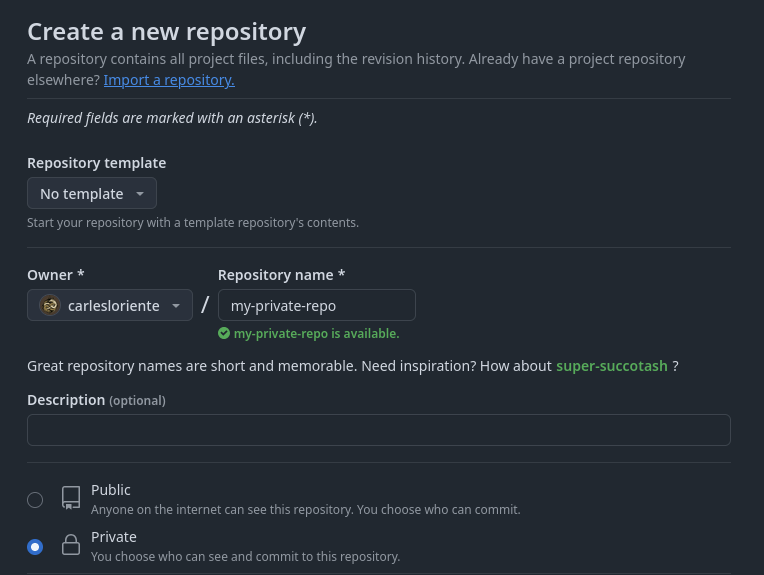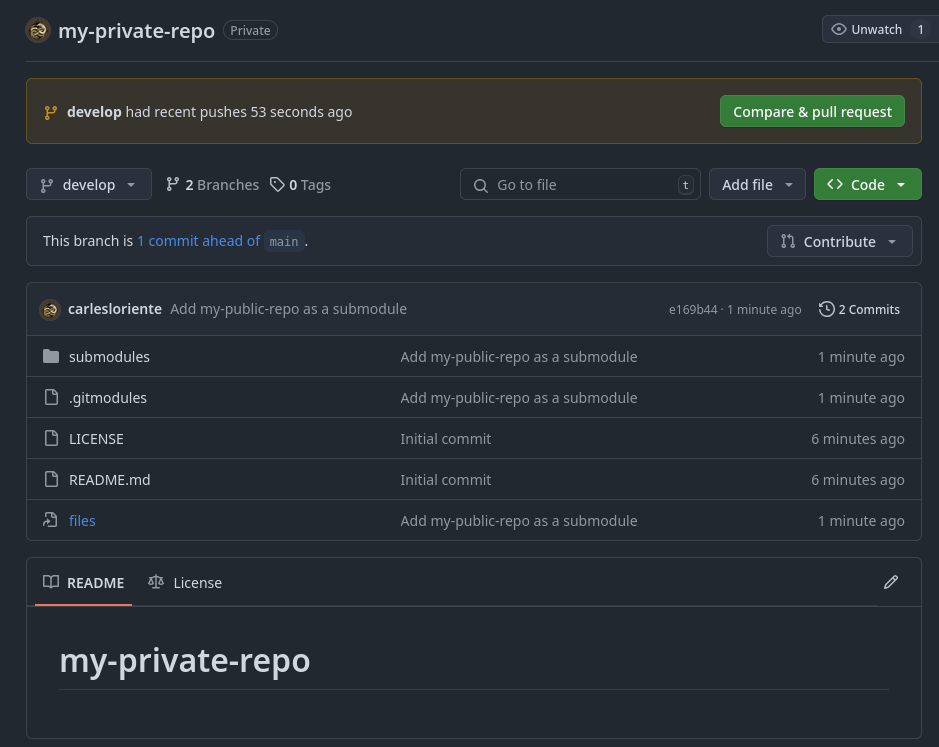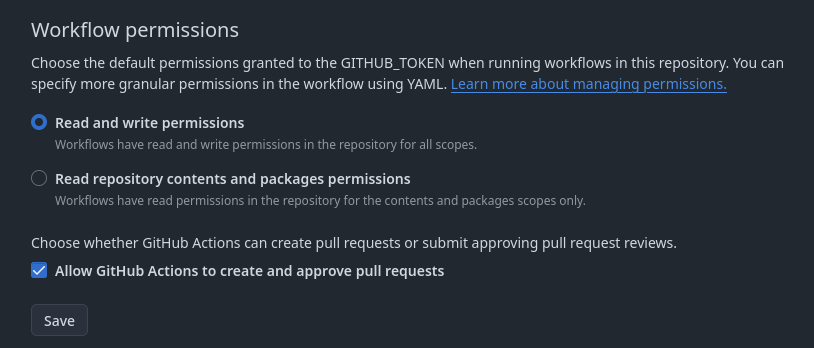GitHub Actions for Updating Git Submodules in Private Repos
Synchronizing Private Projects with Public Repos
Introduction
Git submodules allow you to integrate code from a separate Git repository (in this case, a public repository) into your main project (a private repository). This is valuable for managing reusable components or external libraries. However, keeping these submodules up-to-date can be challenging.
In this post I will guide you through updating a submodule within a private repository whenever the corresponding public repository is updated. We’ll leverage GitHub Actions workflows and explore the necessary configurations in both repositories, including the use of secrets for secure authentication.
Key aspects covered:
- Setting up a public repository on GitHub.
- Creating a private repository with a submodule pointing to the public repository.
- Configuring a GitHub Actions workflow in the private repository to trigger on pushes to the public repository.
- Implementing the submodule update logic within the workflow using Git commands.
- Defining and utilizing necessary secrets in both repositories for secure access and authentication.
Let’s get started
Public repository setup
Create your public repo, in this guide i created my-public-repo at github.com, you can check it out here.
Clone it to your local machine:
git clone git@github.com:carlesloriente/my-public-repo.git
Create the folder files and create a new file file.txt and do your first commit:
git checkout -b main
mkdir files
touch files/file.txt
git add .
git commit -m "Add file.txt"
git push -u origin main
Action sending repository event
Back to your local machine, go to my-public-repo and create the github workflows folder:
mkdir -p .github/workflows
To send and receive events from one repo to another, we are going to use the action repository-dispatch by Peter Evans, create the workflow file .github/workflows/updates_dispatch.yml, with the following content (replace carlesloriente/my-private-repo with your private repo):
name: Dispatch Updates
on:
push:
branches:
- main
jobs:
dispatch:
runs-on: ubuntu-24.04
steps:
- uses: peter-evans/repository-dispatch@v3
with:
token: ${{ secrets.PAT }}
repository: carlesloriente/my-private-repo
event-type: updating
Commit the changes:
git add .github/workflows/updates_dispatch.yml
git commit -m "[skip actions] Add updates_dispatch.yml"
git push origin main
ⓘ The [skip actions] in the commit message is used to avoid triggering the workflow when pushing changes to the public repository.
Now, go to your public repo at github.com and click the Actions tab, you will see the new workflow Dispatch Updates.
Updates_dispatch action explanation
The workflow is triggered by a push event specifically to the main branch of the current repository (my-public-repo).
- Job named “dispatch” is executed.
- Steps
- Dispatch Update Event:
- The peter-evans/repository-dispatch@v3 action is used to dispatch a custom event.
- The token input utilizes the secrets.PAT repository secret for authentication.
- The repository input specifies the target repository for the dispatched event (carlesloriente/my-private-repo).
- The event-type input defines the name of the custom event as “updating”.
- Dispatch Update Event:
Key Considerations:
- This workflow relies on the secrets.PAT repository secret for authentication.
- The target repository for the dispatched event (carlesloriente/my-private-repo) needs to be configured appropriately.
- The event-type (“updating”) can be customized to any desired value.
Private repository setup
Create the private repo, I created my-private-repo at github.com, you can check it out here.

Now, clone the my-private-repo to your local machine (replace carlesloriente with your username):
git clone git@github.com:carlesloriente/my-private-repo
Create the new branches main and develop, and commit the main branch:
git checkout -b main
touch README.md
git add .
git commit -m 'Initial commit'
git push -u origin main
git checkout -b develop
Add the my-public-repo as a submodule to my-private-repo, create a folder named submodules and run the following command:
mkdir submodules
git submodule add git@github.com:carlesloriente/my-public-repo submodules/my-public-repo
git submodule update --init --recursive
It will add the my-public-repo as a submodule to the folder submodules/my-public-repo.
Create a symlink to the folder files in the root of my-private-repo:
ln -ns submodules/my-public-repo/files files
Commit the changes:
git add .
git commit -m "Add my-public-repo as a submodule"
Push the changes to the remote repository:
git push -u origin develop
You can check the changes at the branch develop of my-private-repo, you will see the my-public-repo as a submodule.

After the pull request is merged, go to Settings-> Personal access tokens and create a new token with the following permissions:
- Read access to:
- actions
- metadata
- repo
- Read and write access to:
- workflows
- commit statuses
- pull requests
Copy the token and go to Settings-> Secrets and Variables-> Actions of m̀y-private-repo on github.com:
- Add a new secret named PAT with the previously copied token value
- Add a new secret named OWNER_EMAIL with your email
Now, go to Settings-> Secrets and Variables-> Actions of my-public-repo and add the same secrets.
Action triggered by repository event
Go to Settings-> Actions-> General of my-private-repo on github.com and enable the following permissions:
- Click the checkbox “Read and write permissions” button.
- Click the checkbox “Allow Github Actions to create and approve pull requests”.

Back to your local machine (my-private-repo), create the github workflows folder:
mkdir -p .github/workflows
We are going to use the action checkout provided by github, so create the workflow file .github/workflows/update_on_event.yml, with the following content (replace ENV variable; MODULE_PATH with your value):
name: Updating Submodule
on:
repository_dispatch:
types:
- updating
jobs:
update:
runs-on: ubuntu-24.04
permissions:
contents: write
pull-requests: write
steps:
- name: Checkout repository
uses: actions/checkout@v3
with:
token: ${{ secrets.PAT }}
submodules: recursive
- name: Configure git user
env:
OWNER_EMAIL: ${{ secrets.OWNER_EMAIL }}
run: |
git config --global user.email "$OWNER_EMAIL"
git config --global user.name "PRBot"
- name: Generate Unique variable based on timestamp
run: echo BRANCH=$(date +%s) >> $GITHUB_ENV
- name: Update submodules
run: |
git submodule update --init --recursive --remote
- name: Commit changes
run: |
git add .
git commit -m "Update submodules"
- name: Create and push new branch
run: |
git checkout -b ${{ env.BRANCH }}
git push origin ${{ env.BRANCH }}
- name: Create pull request
env:
GITHUB_TOKEN: ${{ secrets.PAT }}
run: |
gh pr create -B develop -H ${{ env.BRANCH }} --title "PR: Submodule update to develop" --body "Created by Github action"
Commit the changes:
git add .github/workflows/update_on_event.yml
git commit -m "Add update_on_event.yml workflow"
git push origin develop
Go to github.com and create a pull request to merge the branch develop to main. Click the Actions tab, you will see the new workflow Updating Submodule.
Update_on_event action explanation
The workflow is triggered by a custom repository_dispatch event named “updating”. This allows you to manually initiate the update process from within your repository (my-private-repo).
- The job named “build” is executed and requires write permissions to both; repository contents and pull requests.
- Steps
- Checkout: actions/checkout@v4 will check out the repository code, including the submodule, using a Personal Access Token (PAT) stored in secrets.PAT repository secret.
- Updates Submodule:
- Navigates to the submodule directory.
- Sets the Git user email to a value retrieved from the secrets.OWNER_EMAIL repository secret.
- Fetches and pulls the latest changes from the submodule’s remote repository.
- Navigates back to the main repository directory.
- Stages the updated submodule.
- Commits the changes with a message indicating the submodule update.
- Pushes the changes creating a new branch.
- Creates a pull request from the new branch to the main branch using the GitHub CLI (gh).
Testing Workflows and Synchronization
Make a change to my-public-repo and push the changes to the main branch.
touch files/file2.txt
git add .
git commit -m "Add file2.txt"
git push origin main
After the push, go to the Actions tab of my-public-repo and you will see the workflow Dispatch Updates running.

After the workflow finishes, go to the Actions tab of my-private-repo and you will see the workflow Updating Submodule running.

After the workflow finishes, go to the Pull requests tab of my-private-repo and you will see a new pull request created by the workflow.

When the pull request is merged, the submodule will be updated to the latest commit of the public repository.
Conclusion
GitHub Actions offers a vast array of features and capabilities beyond what we’ve covered here. Dive deeper into the documentation and explore its potential to further automate your workflows.
If you found this valuable, consider starring the project’s consider starring the project’s GitHub repository 🌟. Share this knowledge with your network by spreading the word about this post! 🌍
Thanks for reading! 🚀
What’s Next?
- Explore advanced GitHub Actions features and capabilities to further optimize your workflows.
- Experiment
- Share your feedback and experiences with the GitHub community.
- Stay updated with the latest GitHub Actions updates and best practices.
Additional Resources
Tags:
Found a snippet that saved your day? Consider dropping a tip!